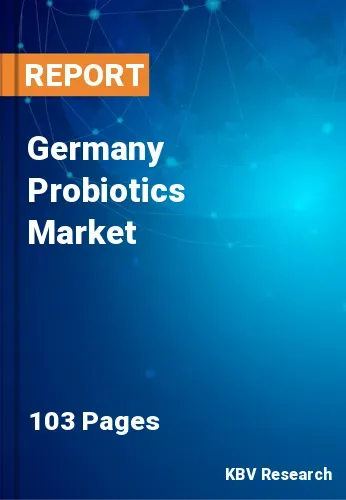Chapter 1. Market Scope & Methodology
1.1 Market Definition
1.2 Objectives
1.3 Market Scope
1.4 Segmentation
1.4.1 Germany Probiotics Market, by Ingredient
1.4.2 Germany Probiotics Market, by Product
1.4.3 Germany Probiotics Market, by End-use
1.4.4 Germany Probiotics Market, by Distribution Channel
1.5 Methodology for the research
Chapter 2. Market Overview
2.1 Introduction
2.1.1 Overview
2.1.1.1 Market Composition and Scenario
2.2 Key Factors Impacting the Market
2.2.1 Market Drivers
2.2.2 Market Opportunities
2.2.3 Market Restraints
2.2.4 Market Challenges
2.2.5 Market Trends
Chapter 3. Competition Analysis - Global
3.1 KBV Cardinal Matrix
3.2 Recent Industry Wide Strategic Developments
3.2.1 Partnerships, Collaborations and Agreements
3.2.2 Product Launches and Product Expansions
3.2.3 Acquisition and Mergers
3.2.4 Expansion
3.3 Market Share Analysis, 2022
3.4 Top Winning Strategies
3.4.1 Key Leading Strategies: Percentage Distribution (2019-2023)
3.4.2 Key Strategic Move: (Product Launches and Product Expansions : 2020, Jun – 2023, Oct) Leading Players
3.5 Porter’s Five Forces Analysis
Chapter 4. Germany Probiotics Market
4.1 Germany Probiotics Market by Ingredient
4.2 Germany Probiotics Market by Product
4.2.1 Germany Probiotics Market by Probiotic Food & Beverages Type
4.3 Germany Probiotics Market by End-use
4.4 Germany Probiotics Market by Distribution Channel
Chapter 5. Company Profiles – Global Leaders
5.1 Chr. Hansen Holding A/S
5.1.1 Company Overview
5.1.2 Financial Analysis
5.1.3 Segment & Regional Analysis
5.1.4 Research & Development Expense
5.1.5 Recent strategies and developments:
5.1.5.1 Partnerships, Collaborations, and Agreements:
5.1.5.2 Product Launches and Product Expansions:
5.1.5.3 Acquisition and Mergers:
5.1.6 SWOT Analysis
5.2 Nestle S.A
5.2.1 Company Overview
5.2.2 Financial Analysis
5.2.3 Segmental and Regional Analysis
5.2.4 Research & Development Expenses
5.2.5 Recent strategies and developments:
5.2.5.1 Product Launches and Product Expansions:
5.2.6 SWOT Analysis
5.3 Probi AB (Symrise AG)
5.3.1 Company Overview
5.3.2 Financial Analysis
5.3.3 Regional Analysis
5.3.4 Research & Development Expense
5.3.5 Recent strategies and developments:
5.3.5.1 Partnerships, Collaborations, and Agreements:
5.3.6 SWOT Analysis
5.4 Arla Foods, Inc.
5.4.1 Company Overview
5.4.2 Financial Analysis
5.4.3 Regional Analysis
5.4.4 Research & Development Expense
5.4.5 SWOT Analysis
5.5 Kerry Group PLC
5.5.1 Company Overview
5.5.2 Financial Analysis
5.5.3 Segmental and Regional Analysis
5.5.4 Research & Development Expenses
5.5.5 SWOT Analysis
5.6 BioGaia AB
5.6.1 Company Overview
5.6.2 Financial Analysis
5.6.3 Segmental and Regional Analysis
5.6.4 Research & Development Expense
5.6.5 Recent strategies and developments:
5.6.5.1 Partnerships, Collaborations, and Agreements:
5.6.5.2 Product Launches and Product Expansions:
5.6.6 SWOT Analysis
5.7 Yakult Honsha Co., Ltd.
5.7.1 Company Overview
5.7.2 Financial Analysis
5.7.3 Segmental and Regional Analysis
5.7.4 Research & Development Expenses
5.7.5 Recent strategies and developments:
5.7.5.1 Product Launches and Product Expansions:
5.7.5.2 Geographical Expansions:
5.7.6 SWOT Analysis
5.8 Danone S.A.
5.8.1 Company Overview
5.8.2 Financial Analysis
5.8.3 Category and Regional Analysis
5.8.4 Recent strategies and developments:
5.8.4.1 Product Launches and Product Expansions:
5.8.5 SWOT Analysis
5.9 Lallemand, Inc.
5.9.1 Company Overview
5.9.2 Recent strategies and developments:
5.9.2.1 Partnerships, Collaborations, and Agreements:
5.9.2.2 Product Launches and Product Expansions:
5.9.2.3 Acquisition and Mergers:
5.9.3 SWOT Analysis
5.10. General Mills, Inc.
5.10.1 Company Overview
5.10.2 Financial Analysis
5.10.3 Segmental and Regional Analysis
5.10.4 Research & Development Expense
5.10.5 Recent strategies and developments:
5.10.5.1 Partnerships, Collaborations, and Agreements:
5.10.6 SWOT Analysis

